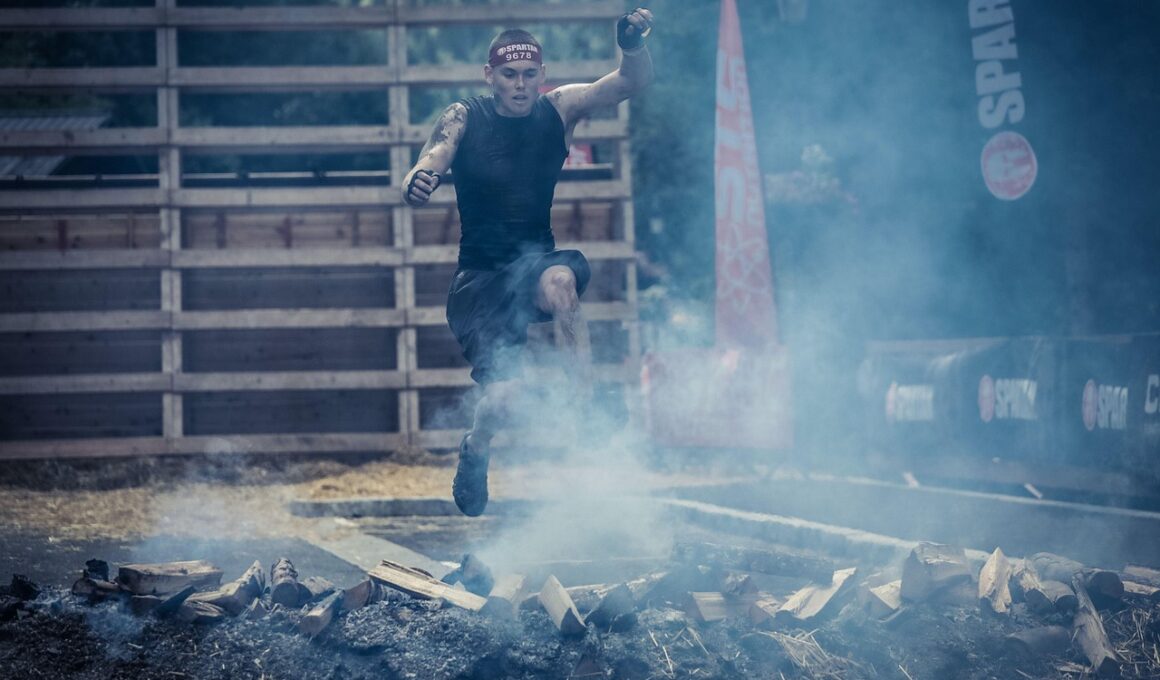Understanding Heat-Related Illnesses
Heat-related illnesses are significant risks faced by athletes, especially in intense sports like obstacle course racing (OCR). Factors contributing to these issues include high temperatures, humidity, and prolonged exertion. The body regulates its temperature primarily through sweating and increased blood circulation to the skin, which can become overwhelmed in extreme conditions. Awareness of symptoms is crucial among racers. The most common forms of heat-related issues include heat cramps, heat exhaustion, and heat stroke. Heat cramps manifest as painful muscle cramps usually due to dehydration and electrolyte imbalance. On the other hand, heat exhaustion comes with symptoms such as heavy sweating, weakness, and fainting, indicating that immediate action is required. The most severe condition, heat stroke, occurs when the body temperature rises above 104°F (40°C), leading to confusion and unconsciousness. Among all participants, understanding how to recognize early signs can effectively prevent severe consequences. Proper hydration strategies and acclimatization methods are key interventions that should be emphasized during training and competitions. Being well-informed aids in ensuring safety and optimizing performance during races.
Importance of Hydration
Staying hydrated is essential for preventing heat-related illnesses during OCR events. Dehydration can lead to decreased physical performance, impair decision-making, and increase the risk of heat illnesses. Athletes should start hydrating before the race, ensuring they drink enough fluids to maintain their hydration status. It’s recommended to consume water and electrolyte drinks throughout the event, particularly in hot conditions. Planning a hydration schedule can be advantageous, allowing racers to gauge their fluid intake and prevent dehydration proactively. During races, participants should familiarize themselves with available hydration stations, ensuring they take advantage of these resources when necessary. Understanding the difference between thirst and dehydration is crucial. Thirst often signals that the body is already dehydrated, which may hinder performance. Additionally, factors such as sweat rates and body weight play significant roles in individual hydration strategies. Some may require more fluids due to high sweat rates, while others may have lower needs. Athletes should practice their hydration strategies during training, determining which combinations of fluids work best for their body. This knowledge plays a pivotal role in enhancing resilience during competitions and safeguarding against heat-related health concerns.
Acclimatization Techniques
Acclimatization is crucial for OCR athletes preparing for events in hot conditions. This process involves gradually exposing the body to increasing temperatures to enhance its ability to regulate heat. Effective acclimatization typically takes about 10 to 14 days, allowing the body to adapt through various physiological changes. These adaptations include improved sweating efficiency and increased blood plasma volume, both crucial for maintaining performance in extreme heat. To start acclimatization, participants should engage in training sessions during warmer parts of the day, gradually increasing session intensity and duration. Moreover, athletes should aim to maintain appropriate clothing, wearing lighter fabrics that permit sweat evaporation. Monitoring heart rates, perceived exertion, and hydration levels during this process helps to discern how well the body is adapting. Techniques such as using cooling strategies before races, such as ice vests, can further support the acclimatization process. It is essential for athletes to listen to their bodies, ensuring that training is adjusted according to individual responses. Through proper acclimatization, athletes can significantly reduce the likelihood of experiencing heat-related illnesses during their OCR events.
Identifying Heat Illness Signs
Recognizing the early signs of heat-related illnesses is critical in obstacle course racing. Effective identification can help athletes take corrective actions before their condition worsens. Symptoms of heat cramps include sudden muscle contractions and spasms, typically in the leg, back, or abdominal muscles. These cramps often result from dehydration or electrolyte loss during intense exertion. Conversely, heat exhaustion can present with various symptoms such as heavy sweating, weakness, dizziness, and nausea. Early intervention is crucial at this stage. Athletes experiencing these symptoms should immediately find a cooler environment, hydrate, and rest. Should signs progress to heat stroke, symptoms escalate to confusion, disorientation, high body temperature, and potential loss of consciousness. Heat stroke requires immediate medical attention, as it can be life-threatening. Athletes participating in OCR events should create a checklist of symptoms and raise awareness among teammates. This proactive approach allows for quicker responses to early signs of heat-related illnesses. Additionally, regular training in the heat can help develop an athlete’s ability to recognize their body’s signals and respond appropriately during competitions.
Recovery Strategies Post-Event
Recovery after an obstacle course race in hot weather is vital for long-term health and performance. Following physically demanding activities, athletes may experience fatigue and dehydration, making proper recovery essential. The first step is to rehydrate with water and electrolytes to restore lost fluids through sweat. This process should begin immediately after the race, ensuring that the body recovers optimally. Consuming recovery snacks containing complex carbohydrates and protein within thirty minutes post-race can also aid muscle recovery. Incorporating gentle cool-down exercises, such as stretching or light jogging, helps alleviate muscle stiffness and promotes blood flow. Additionally, rest should not be underestimated; ensuring adequate sleep allows the body to repair and regenerate effectively. Athletes should monitor their bodies for lingering effects of heat exposure, such as dizziness or prolonged fatigue, as these may indicate inadequate recovery. Following extensive training or events, soothing therapies like ice baths or sports massages can further enhance recovery and prevent muscle soreness. Attentive recovery strategies boost overall performance in subsequent races and maintain an athlete’s well-being in extreme heat conditions.
Long-Term Health Considerations
Injuries and illnesses experienced during obstacle course racing can have long-term effects on athletes’ health, especially concerning heat-related illnesses. Continuous exposure to high temperatures can lead to chronic issues such as heat intolerance and cardiovascular strain. Therefore, long-term health strategies should prioritize adaptive training and awareness of body limits concerning heat exposure. Engaging in regular health check-ups allows athletes to monitor their physiological adaptations to extreme temperatures. This proactive measure can identify potential ongoing issues, such as blood pressure regulation and hydration statuses. Building a strong foundation through consistent, moderate-intensity training prepares athletes to handle greater challenges safely. Moreover, athletes should prioritize nutrition, focusing on a balanced diet that underlines hydration, electrolytes, and essential nutrients. Psychological wellness plays a role, as consistent racing and intense training can lead to mental fatigue. Strategies such as recovery workshops and support systems can encourage healthy emotional coping mechanisms for athletes facing the pressures of competitive environments. By fostering an integrated approach to their health, OCR athletes can cultivate resilience to heat-related illnesses and enhance their performance sustainability.
Conclusion and Recommendations
Mitigating heat-related risks in obstacle course racing requires a comprehensive understanding of prevention, recognition, and recovery. Athletes are encouraged to establish hydration routines, acclimatization practices, and symptom awareness. Achieving well-rounded knowledge around these aspects will enable racers to make informed decisions regarding their health during training and competition. Keep in mind the importance of listening to one’s body; if symptoms arise, it’s vital to take immediate action. Engaging with a community of fellow athletes fosters an environment of shared knowledge regarding best practices for battling heat exposure. Furthermore, race organizers can provide vital information and resources on hydration and health strategies during events, ensuring participants are informed. Incorporating recovery plans after races aids in long-term well-being, optimizing performance and allowing for a sustainable racing career. Professional guidance, such as working with sports nutritionists and trainers, can accentuate these strategies within training programs. Ultimately, prioritizing overall health and taking precautions creates a safer and more enjoyable environment in obstacle course racing. Handle heat-related challenges head-on, safeguarding your well-being while achieving your OCR goals.
Final Tips for Athletes
In preparing for obstacle course races amid high temperatures, athletes should continuously adapt their training regimens. Always be on the lookout for updated heat advisories and plan race morning strategies accordingly. Pre-race preparation should entail ensuring all hydration resources are readily available. Athletes can carry personal hydration packs to maintain control over their intake during races, which can improve both comfort and performance. Practice techniques like cooling strategies pre- and post-race to help maintain core body temperatures. Prioritizing adequate sleep before events aids in recovery and boosts overall performance in hot conditions. Moreover, take the opportunity to discuss heat-related risks with coaches and peers, ensuring an open dialogue environment. Know your limits and use your experiences to refine your strategies during training, preparing you for the realities of racing in the heat. Explore resources on heat illnesses and hydration techniques to be well-informed. In conclusion, adopting a proactive approach can safeguard health and significantly improve performance under challenging conditions in obstacle course racing.


